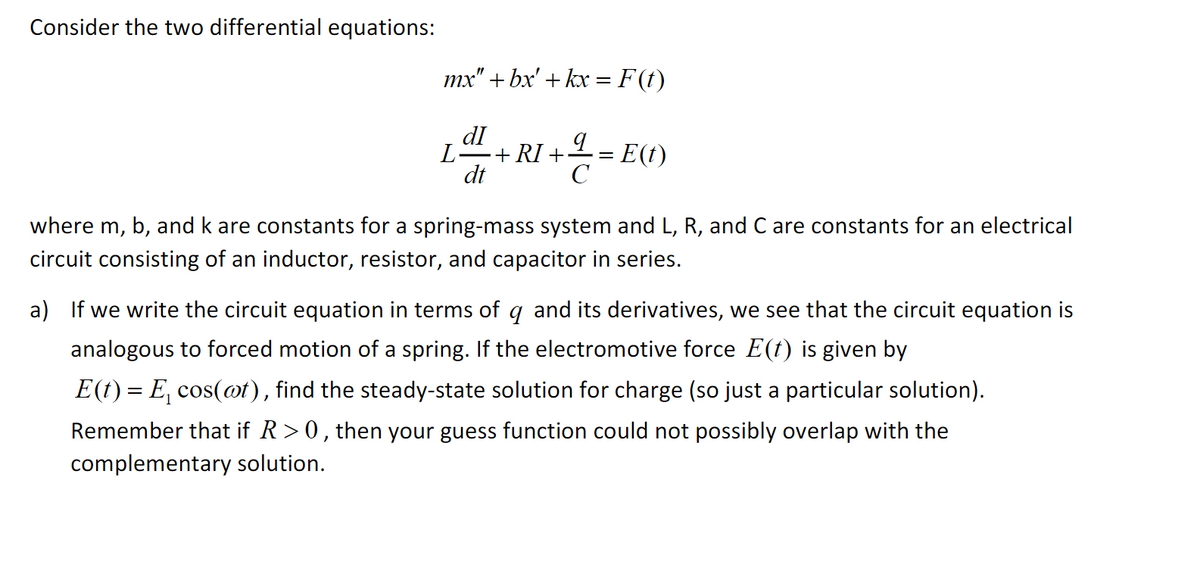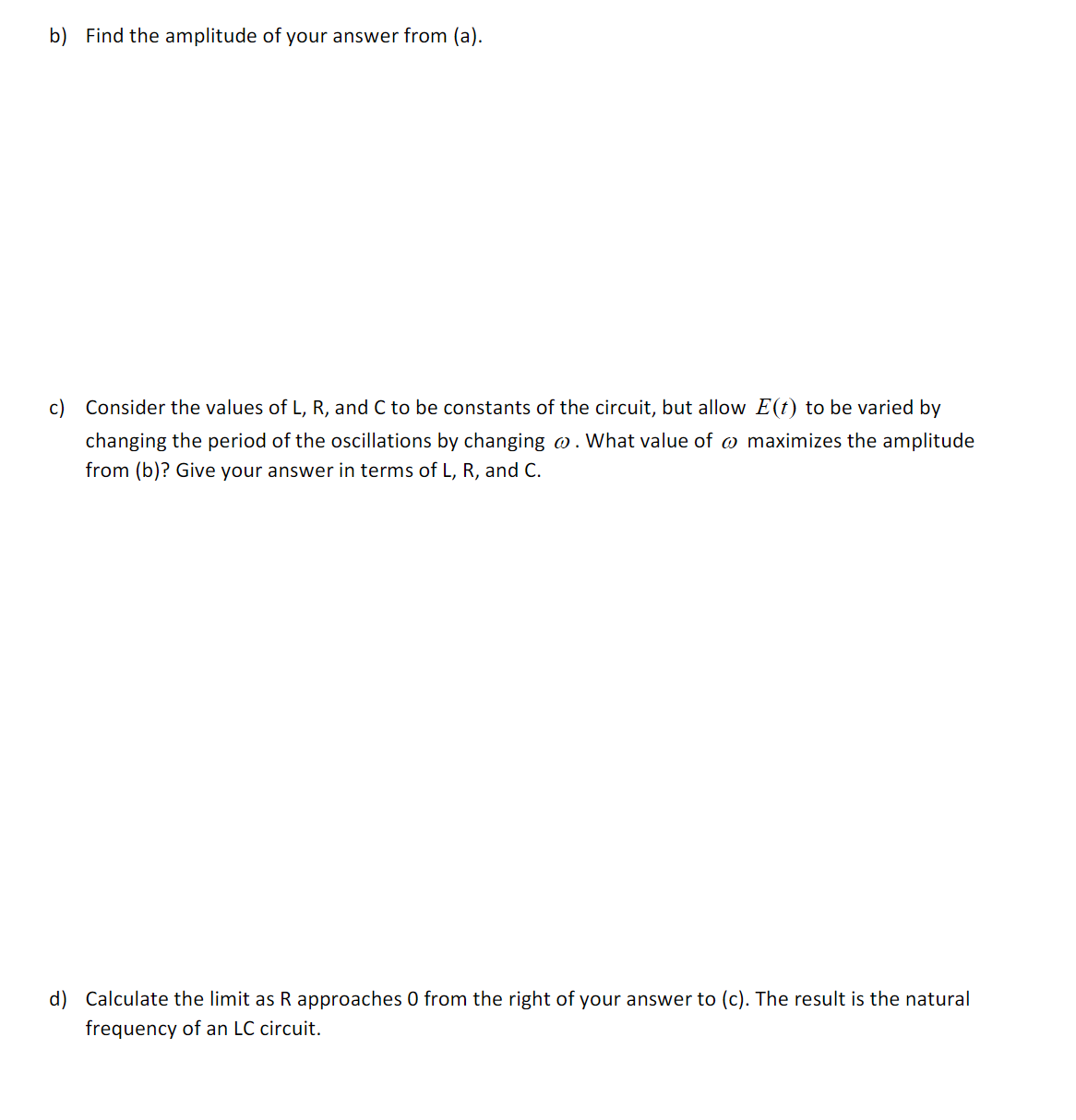Consider the two differential equations: тx" + bx' + kx%3D F(t) dI + RI +1 = dt E(t) C where m, b, and k are constants for a spring-mass system and L, R, and C are constants for an electrical circuit consisting of an inductor, resistor, and capacitor in series. a) If we write the circuit equation in terms of q and its derivatives, we see that the circuit equation is analogous to forced motion of a spring. If the electromotive force E(t) is given by E(t) = E, cos(@t), find the steady-state solution for charge (so just a particular solution). Remember that if R>0, then your guess function could not possibly overlap with the complementary solution.
Consider the two differential equations: тx" + bx' + kx%3D F(t) dI + RI +1 = dt E(t) C where m, b, and k are constants for a spring-mass system and L, R, and C are constants for an electrical circuit consisting of an inductor, resistor, and capacitor in series. a) If we write the circuit equation in terms of q and its derivatives, we see that the circuit equation is analogous to forced motion of a spring. If the electromotive force E(t) is given by E(t) = E, cos(@t), find the steady-state solution for charge (so just a particular solution). Remember that if R>0, then your guess function could not possibly overlap with the complementary solution.
Introductory Circuit Analysis (13th Edition)
13th Edition
ISBN:9780133923605
Author:Robert L. Boylestad
Publisher:Robert L. Boylestad
Chapter1: Introduction
Section: Chapter Questions
Problem 1P: Visit your local library (at school or home) and describe the extent to which it provides literature...
Related questions
Question

Transcribed Image Text:Consider the two differential equations:
mx" + bx' + kx = F (t)
dI
L= E(t)
L
+ RI +
dt
C
where m, b, and k are constants for a spring-mass system and L, R, and C are constants for an electrical
circuit consisting of an inductor, resistor, and capacitor in series.
a)
we write the circuit equation in terms of g and its derivatives, we see that the circuit equation is
analogous to forced motion of a spring. If the electromotive force E(t) is given by
E(t) = E, cos(ot), find the steady-state solution for charge (so just a particular solution).
Remember that if R> 0, then your guess function could not possibly overlap with the
complementary solution.

Transcribed Image Text:b) Find the amplitude of your answer from (a).
c) Consider the values of L, R, and C to be constants of the circuit, but allow E(t) to be varied by
changing the period of the oscillations by changing o. What value of w maximizes the amplitude
from (b)? Give your answer in terms of L, R, and C.
d) Calculate the limit as R approaches 0 from the right of your answer to (c). The result is the natural
frequency of an LC circuit.
Expert Solution
This question has been solved!
Explore an expertly crafted, step-by-step solution for a thorough understanding of key concepts.
This is a popular solution!
Trending now
This is a popular solution!
Step by step
Solved in 4 steps with 1 images

Knowledge Booster
Learn more about
Need a deep-dive on the concept behind this application? Look no further. Learn more about this topic, electrical-engineering and related others by exploring similar questions and additional content below.Recommended textbooks for you

Introductory Circuit Analysis (13th Edition)
Electrical Engineering
ISBN:
9780133923605
Author:
Robert L. Boylestad
Publisher:
PEARSON

Delmar's Standard Textbook Of Electricity
Electrical Engineering
ISBN:
9781337900348
Author:
Stephen L. Herman
Publisher:
Cengage Learning

Programmable Logic Controllers
Electrical Engineering
ISBN:
9780073373843
Author:
Frank D. Petruzella
Publisher:
McGraw-Hill Education

Introductory Circuit Analysis (13th Edition)
Electrical Engineering
ISBN:
9780133923605
Author:
Robert L. Boylestad
Publisher:
PEARSON

Delmar's Standard Textbook Of Electricity
Electrical Engineering
ISBN:
9781337900348
Author:
Stephen L. Herman
Publisher:
Cengage Learning

Programmable Logic Controllers
Electrical Engineering
ISBN:
9780073373843
Author:
Frank D. Petruzella
Publisher:
McGraw-Hill Education

Fundamentals of Electric Circuits
Electrical Engineering
ISBN:
9780078028229
Author:
Charles K Alexander, Matthew Sadiku
Publisher:
McGraw-Hill Education

Electric Circuits. (11th Edition)
Electrical Engineering
ISBN:
9780134746968
Author:
James W. Nilsson, Susan Riedel
Publisher:
PEARSON

Engineering Electromagnetics
Electrical Engineering
ISBN:
9780078028151
Author:
Hayt, William H. (william Hart), Jr, BUCK, John A.
Publisher:
Mcgraw-hill Education,